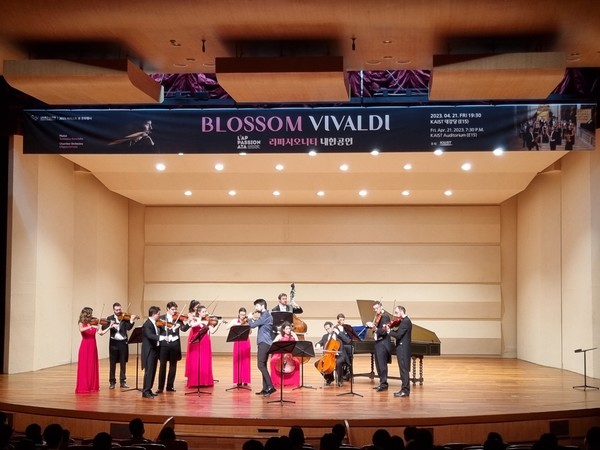
As the semester goes on and the weeks fly by in the blink of an eye, the last thing you’d probably like to be reminded of is the examination week — a week of continuous studying, sleep deprivation, and voids created on the many aisles of the campus’ convenience stores from grabbing quick meals between study sessions. While living through exhausting, stressful times like these, nothing’s better than being able to look forward to a recreational refreshment at the end of the week. KAIST provided just that on the last day of midterms week by hosting its 687th KAIST Cultural Event titled Blossom Vivaldi.
The KAIST Cultural Event on April 21 featured L’Appassionata, a 2019-found chamber orchestra consisting of professional Italian musicians. Despite being young for the craft that they’re in, they have a rich history in performing with numerous noteworthy Italian orchestras. L’Appassionata itself is renowned for its two recording projects of pieces by Baroque composers, namely Antonio Vivaldi — whose works were showcased in Blossom Vivaldi — and Johann Sebastian Bach. Tommaso Benciolini, Italian flute soloist and professor who won the prestigious New York Respighi Award in 2017, was spotlighted as the soloist for six of the eight pieces included in the program at KAIST. Benciolini collaborated with L’Appassionata on their recording project, Vivaldi: Original Flute Concertos, which was met with great success and blossomed into this cultural event that KAISTians had the privilege to experience.
The musical compositions played at Blossom Vivaldi were from the Baroque period, which began in the early 17th century. Much like the word it was derived from, barroco (meaning “oddly shaped pearl”), some classify the Baroque period as eccentric and unconventional, with artists producing prominent, majestic, and vibrant sculptures, architecture, dances, and other forms of art. In music specifically, the Baroque style is characterized by polyphonic compositions, drastic changes in dynamics, and lower frequency tuning, reflected in the works of renowned musicians like Bach (notable for his composition “Ave Maria”) and Johann Pachelbel (notable for his composition, “Canon in D”). One big face of classical music is “Four Seasons”, composed by Vivaldi, whose repertoires were played by L’Appassionata and Benciolini in this event.
Being an avid listener of classical music, there came a point when I started to recognize the distinction between repertoires from the Classical, Romantic, and Baroque eras. The assertive phrasing, the harmonious rhythm, the impressive chord progressions — Benciolini conveyed and reflected these attributes that make up the heart of Baroque music through his performance. His quick but accurate notes in the first movement of “Flute Concerto in A minor, RV 440”, his nuanced articulation in the second movement of “Flute Concerto in D major, RV 429”, and his smooth-flowing yet energetic runs in the third movement of “Flute Concerto in G major, RV 435” strongly reflected the ambience that Vivaldi’s compositions emanate.
Certainly, one shouldn’t forget the harmony and Baroque-like atmosphere established by L’Appassionata with their astonishing accompaniments that took us back to the 1600s. The chamber orchestra played equally well and served a vital part in creating the experience, as well as complementing Benciolini’s solos. The musicians knew how to balance dynamics, the tempo at which the accompanying sections should be played, and how to match Benciolini’s energy, be it tranquil or spirited, like it was second nature. Even so, they were able to stand on their own as a chamber orchestra producing sublime music. In fact, it was when Benciolini stepped off the stage that I found their playing most impressive — the sound of their instruments reverberating off the four walls of the concert hall and touching the hearts of many, including myself. The long hours of endless practice were manifested in the spectacular performance they delivered. Even without a conductor, L’Appassionata was incredibly synchronized in every piece played, which further displayed their professionalism and extensive experience.
The concert ended with rounds of applause, standing ovations, and commendatory cheers from the crowd, but not without an astonishing encore. It was an experience I thoroughly enjoyed, and it was a great way to restore my mental state to what it was before the midterms week. If they ever come to KAIST to perform again, you will find me sitting at the front-row seats, eagerly waiting to be serenaded by their melodious performance.

